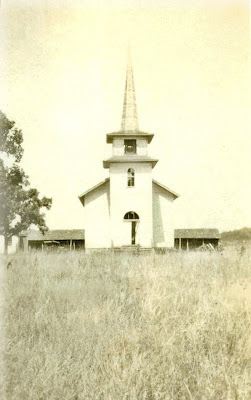
In the mid-1850's the Jackson Mission of the Church of the United Brethren in Christ was formed serving the areas of Grass Lake, Waterloo, Henrietta and Bunkerhill townships--straddling the border of Jackson and Ingham Counties. The Baseline Church--usually found listed simply as Baseline UB Church, was built at Baseline and Haynes Roads in Bunkerhill Township and served families from both Henrietta Township as well at those in Bunkerhill.
My great-great-great-grandparents, Lawrence Hobart and Annice Ann (Aldrich) McCreery were early members of this congregation. They lived nearby and so did many members of their close knit family, including LH's older brother, John Breese McCreery. JB is closely identified with this congregation and is sometimes referred to as a preacher. It is most likely that JB served as a lay-preacher, filling in for the pastor when he was off to another preaching place under his charge, which included churches in the village of Waterloo and First UB Church of Waterloo Township on Parks and Territorial Roads. JB also donated land where the parsonage was built to house the preacher and his family, which would have made the Baseline Church a central location for the preacher.
When Annice Ann McCreery's father Edward Aldrich died in 1890, although not a member of the Baseline congregation, his funeral services were held at the church which was very close to his former residence in along Meridian Road in Henrietta Township.
Succeeding generations of the McCreery family were also members of the Baseline Congregation. On 16 August 1905, my great grandparents Anna Smith (granddaughter of LH and Annice) and Jesse Carley were married at the parsonage by Rev. H. Hollis of the Baseline Church. But it would not be long and the family seems to have become members of the Methodist Episcopal Church in Munith. This has lead me to wonder what happened to the UB Church?
Here are some interesting observations concerning these UB congregation in the Munith-Waterloo area--
Traditionally, the United Brethren in Christ denomination was German speaking. Although much of the Munith-Waterloo area was of German origins, the names that appear associated with the UB congregations don't appear to be Germanic, e.g. McCreery, Smith, McCloys, Parks, Weeks, Garners and Hall. The UB denomination was Wesleyan in theology and the only real difference between this church and the Methodist Episcopal church was the language--UB's speaking German and ME's speaking English. There were ME churches in Fitchburg, Munith, Pleasant Lake and Stockbridge, which were all very close to the Baseline and Waterloo UB Churches. So, what was the attraction of my ancestors to this denomination?
What happened to the Baseline UB Church? Did it disband? Did it merge with another congregation? Are there any records that exist from this rural congregation?
To bring the story of the denominations up to date--in 1946 the UB's merged with another traditionally speaking German-Methodist denomination known as the Evangelical Church to form the Evangelical United Brethren denomination. This is why the Waterloo churches (one at Parks and Territorial Road and the one in the Village of Waterloo) were for a time know as the EUB churches. In 1968 the EUB and Methodist denominations merged to form the United Methodist Church--thus making these former rural churches all part of the United Methodist umbrella.
The religious life of our ancestors can weave and interesting story that many genealogist and family historians fail to recognize. The motivations, attitudes and practices tell us much about the way we were reared and helps us understand the lens with which they viewed the world. I encourage my fellow family historians not to overlook this very important aspect of our ancestors lives.
UPDATE--
I just purchased the book History of the Michigan Conference of the Evangelical United Brethren Church by William H. Watson and A. LaVerne Spafford, Sr., published in 1961. On pages 467-469 a short history of the Waterloo First EUB church appears. In this brief sketch it states, "With the division of the United Brethren Church into liberals and radicals, the Bunker Hill Class went with the radicals." In the 1880's the UB denomination experienced a schism over the revision of the constitution of the organization. The liberal faction updated the constitution with the removal of the prohibition of membership in secret societies and lay representation. A small faction, known as the radicals or the "Old Constitution" members objected to the libralizing of the denomination and in 1889 the two factions parted ways. The "New Constitution" UB Denomination would be eventually merge with the Evangelical Church in 1946. The "Old Constitution" UB Denomination is still in existence today. Based on this sentence from the Watson and Spafford history I conclude that the Bunker Hill UB congregation sided with the "Old Constitution" faction. However, this still does not bring us to the conclusion of when this local church dissolved, died or was abandon.
